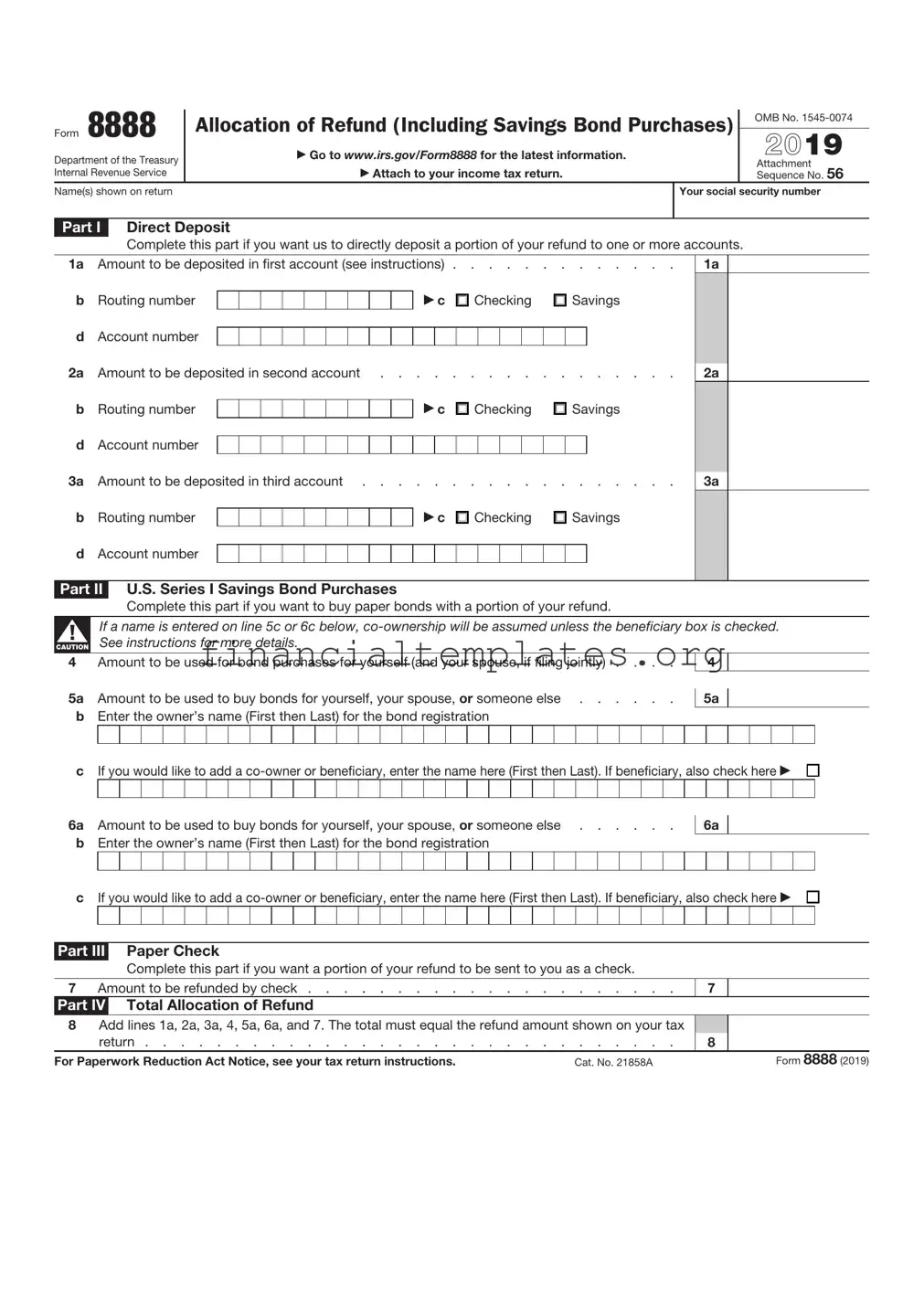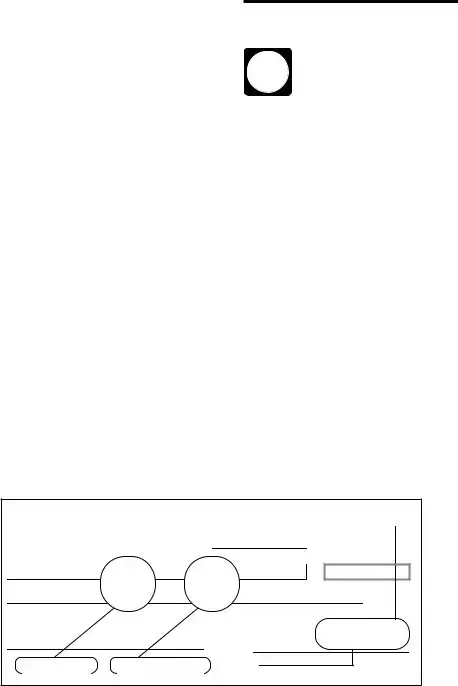Ask your financial institution for the correct routing number to enter if:
•The routing number on a deposit slip is different from the routing number on your checks,
•Your deposit is to a savings account that doesn’t allow you to write checks, or
•Your checks state they are payable through a financial institution different from the one at which you have your account.
Lines 1c, 2c, and 3c
Check the appropriate box for the type of account. Don’t check more than one box for each line. If your deposit is to an account such as an IRA, HSA, brokerage account, or other similar account, ask your financial institution whether you should check the “Checking” or “Savings” box. You must check the correct box to ensure your deposit is accepted. If your deposit is to a TreasuryDirect® online account, check the “Savings” box.
Lines 1d, 2d, and 3d
The account number can be up to 17 characters (both numbers and letters). Include hyphens but omit spaces and special symbols. Enter the number from left to right and leave any unused boxes blank. On the sample check in these instructions, the account number is 20202086. Don’t include the check number.
Reasons Your Direct Deposit Request Will Be Rejected
If any of the following apply, your direct deposit request will be rejected and a check will be sent instead.
•You are asking to have a joint refund deposited to an individual account, and your financial institution(s) won’t allow this. The IRS isn’t responsible if a financial institution rejects a direct deposit.
•The name on your account doesn’t match the name on the refund, and your financial institution(s) won’t allow a refund to be deposited unless the name on the refund matches the name on the account.
•Three direct deposits of tax refunds have already been made to the same account or prepaid debit card.
•You haven’t given a valid account number.
•You file your 2020 return after
November 30, 2021.
If your financial institution rejects one or two but not all of your direct deposit requests, you may get part of your refund as a paper check and part as a direct deposit.
Example. You complete lines 1 and 2 correctly but forget to enter an account number on line 3d. You will get a paper check for any amount shown on line 3a. The parts of your refund shown on lines
1a and 2a will be directly deposited to the accounts you indicated.
The IRS isn’t responsible for a ▲! lost refund if you enter the
wrong account information. CAUTION Check with your financial institution to get the correct routing and account numbers and to make sure your direct deposit will be accepted.
Changes in Refund Due to Math Errors or Refund Offsets
The rules below explain how your direct deposits may be adjusted.
Math Errors
The following rules apply if your refund is increased or decreased due to a math error.
Refund increased. If you made an error on your return and the amount of your refund is increased, the additional amount will be deposited to the last account listed. If you asked that your refund be split among three accounts, any increase will be deposited to the account on line 3. If you asked that your refund be split among two accounts, any increase will be deposited to the account on line 2.
Example. Your return shows a refund of $300 and you ask that the refund be split among three accounts with $100 to each account. Due to an error on the return, your refund is increased to $350. The additional $50 will be added to the deposit to the account on line 3.
Refund decreased. If you made an error on your return and the amount of your refund is decreased, the decrease will be taken first from any deposit to an account on line 3, next from the deposit to the account on line 2, and finally from the deposit to the account on line 1.
Example. Your return shows a refund of $300, and you ask that the refund be split among three accounts with $100 to each account. Due to an error on your return, your refund is decreased by $150. You won’t receive the $100 you asked us to deposit to the account on line 3, and the deposit to the account on line 2 will be reduced by $50.
Note: If you appeal the math error and your appeal is upheld, the resulting refund will be deposited to the account on line 1.
Refund Offset
The following rules apply if your refund is offset (used) to pay past-due federal tax or certain other debts.
Past-due federal tax. If you owe past-due federal tax and your refund is offset by the IRS to pay the tax, the past-due amount will be deducted first from any deposit to an account on line 3, next from the deposit to the account on line 2, and finally from the deposit to the account on line 1.
Other offsets. If you owe other past-due amounts (such as state income tax, child support, spousal support, or certain federal nontax debts, such as student loans) that are subject to offset by the Treasury Department’s Bureau of the Fiscal Service, the past-due amounts will be deducted first from the deposit to the account with the lowest routing number. Any remaining amount due will be deducted from the deposit to the account with the next lowest routing number and then from the deposit to the account with the highest routing number.
If the deposit to one or more of ▲! your accounts is changed due to a math error or refund offset,
CAUTION and that account is subject to contribution limits, such as an IRA, HSA, Archer MSA, or Coverdell ESA, or the deposit was deducted as a contribution to a tax-favored account on your tax return, you may need to correct your contribution or file an amended return.
Example. You deduct $1,000 on your 2020 tax return for an IRA contribution. The contribution is to be made from a direct deposit of your 2020 refund. Due to an offset by the Bureau of the Fiscal Service, the direct deposit isn’t made to your IRA. You need to correct your contribution by contributing $1,000 to the IRA from another source by the due date of your return (determined without regard to any extension) or file an amended return without the IRA deduction.
Part II
You may request up to three different savings bond registrations. However, each registration must be a multiple of $50, and the total of lines 4, 5a, and 6a can’t be more than $5,000 (or your refund amount, whichever is smaller).
You can skip line 4 if you want TIP to buy bonds for someone other
than yourself (and your spouse, if filing jointly).
Line 4
Enter the portion of your refund you want to use to buy bonds for yourself (and your spouse, if filing jointly). These bonds will be registered in the name(s) shown on your return.
Lines 5a and 6a
Enter the portion of your refund you want to use to buy bonds for yourself, your spouse, or someone else. This amount must be a multiple of $50.
Lines 5b and 6b
Enter the owner’s name for this bond registration. This can be you, your spouse, or someone else. However, enter only one name. Enter the first name followed by the



